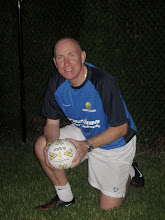It is generally recognized that Brazil has and continues to develop the world's most skillful soccer players. Pele arrived on the world's stage at the 1958 World Cup and since then Brazil has produced great players such as Garrincha, Carlos Alberto, Zico, Socrates, Falcao, Rivelino, Romario, Ronaldo, Robinho and Kaka.
When Brazilian Soccer Schools founder Simon Clifford travelled to Brazil in 1998 to learn why Brazil constantly produced the world's greatest players, he found that Brazilian children spend up to 12-15 hours each week working on their technique with a ball. They are the best in the world because they work harder than any other country at improving their technique with a ball.
Watch Video: Learn to Play the Brazilian Way-Part One
Simon also discovered that the game of Futebol de Salao was another important factor in the development of young skilful Brazilian players. Futebol de Salao is a small-sided version of the full-game played with a smaller, size two ball. The Futebol de Salao ball is much heavier than a conventional ball. It has very little bounce. Instead of kicking the ball long distances and chasing it back and forth, Clifford noticed the Brazilian players used their superior ball handling skills to maintain control and challenge defenders.
It is our belief that young Canadian players can achieve the same results as young players in Brazil providing they are committed to daily practice and a long-term development program. It is not our philosophy to select children on current ability only, as we are confident of producing excellent soccer players, regardless of past experience.
Presently in Canada we do not believe that young children are spending enough time training, They may spend a lot of time playing matches, but generally children do not spend enough time working on their skills. The Brazilian Soccer Schools program provides a full syllabus for children from 5 years old to 16 year old whereby an increased duration of actual time is spent training and working with the ball.
The Brazilian Soccer Schools syllabus covers every aspect of soccer. Our coaching is by no means exclusively Brazilian but there are 4 key aspects that have their origins in Brazil:
o Futebol de Salao
o Emphasis on individual skills
o Increased training time
o Physical Training
We do not focus entirely on the game of Futebol de Salão, although it is an excellent game in its own right. The game is used as a development tool to develop quick feet, close dribbling and passing skills. Children at Brazilian Soccer Schools spend roughly two-thirds of their time working with the size two Futebol de Salão balls and the remaining third with a conventional ball working on areas such as longer passing, shooting, heading and of course match situations.Throughout all ages of our coaching the strongest emphasis is put on developing fully the technical skills of every child. Skills from basic to complex are broken down into easily learnable phases for children and then these moves are taught and repeated many times until the children become accomplished at performing these skills first as individuals and then gradually against other children and later in games. Repetition of all skills from passing the ball in a straight line through to some of the amazing juggling skills you see from our children is stressed throughout.At BSS we also strongly encourage the ethos that it is vitally important for children to become good people before they can become good soccer players. This might sound slightly grandiose but it is something we take very seriously and into the future we hope that people will take notice of this as much as the fantastic players that the program is developing.
An attached video provides an illustration of the type of work that we do. It is our belief if more and more young Canadian players participate in this type of training then we will begin to develop more exciting and talented players, at every level of the game
Subscribe to:
Post Comments (Atom)



No comments:
Post a Comment